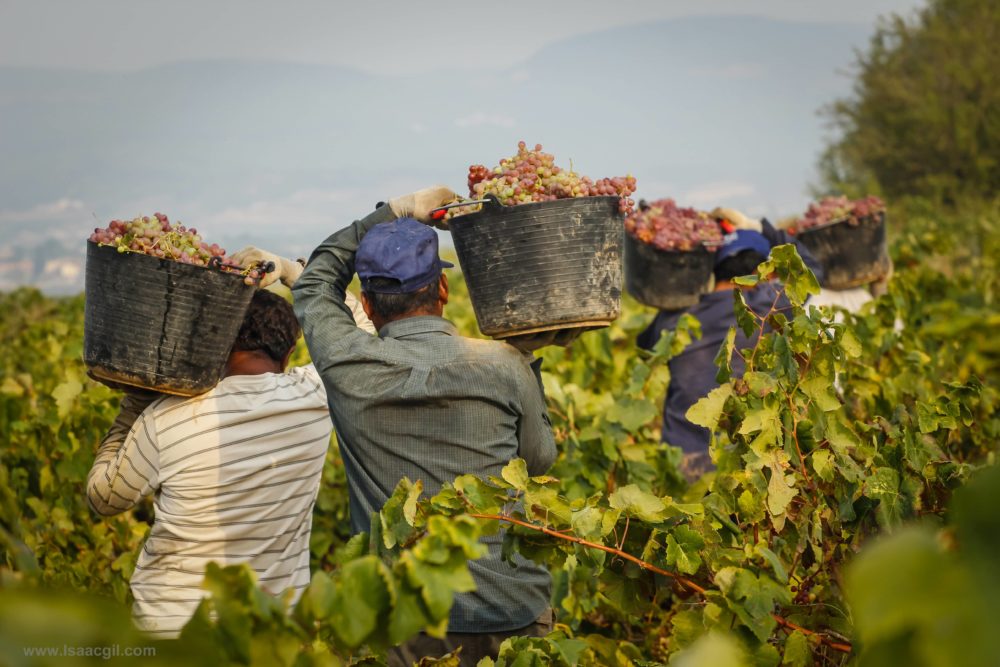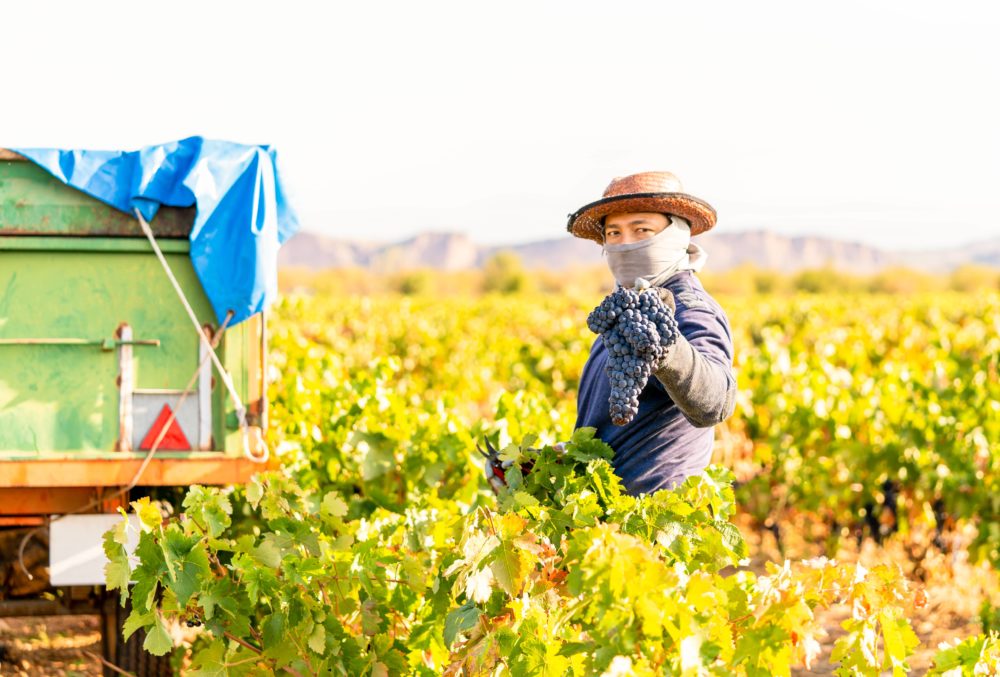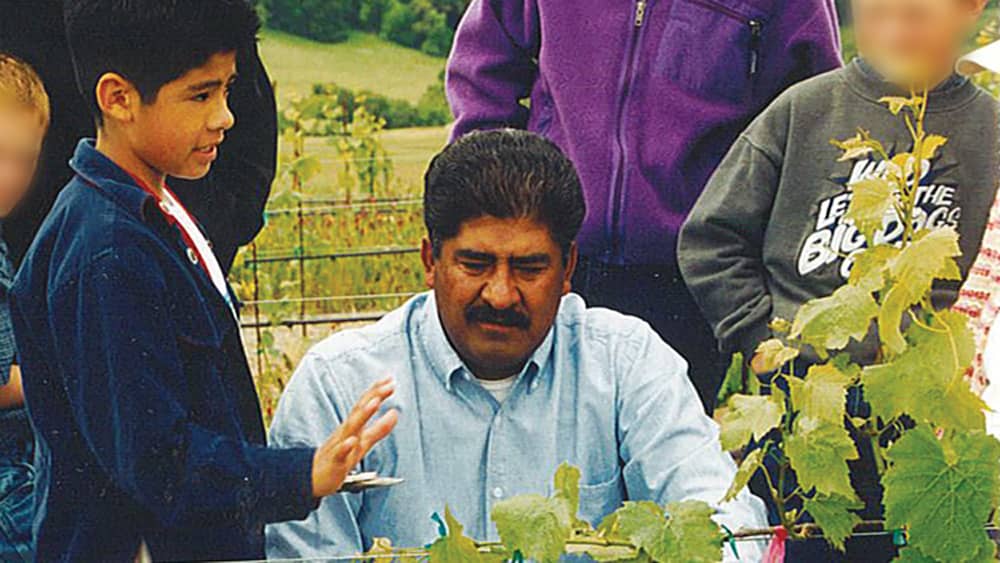
Favorable climate and fertile soil provides prosperity and good fortune for many in the North Bay. Scenarios in books and movies glamorize living on ranches in vineyards, while social media posts depict luxurious experiences of people enjoying fine wine and cuisine. But the farmworkers are the unsung heroes of the vineyards and fields, and without them the economic success of California would not be possible. While the wine industry is often romanticized, working in the vineyards requires skill and hard work.
The vineyard workforce
Since the early 20th century, agricultural labor has been completed mostly by Central and Mexican American migrant workers. Families followed the crop seasons of El Norte, often uprooting their children from schools to go where there was work. Many workers supported families both in the U.S. and their native countries. Former President Lyndon Johnson’s 1965 immigration bill provided a legal framework that prioritized highly-skilled immigrants and opened the door for people with families already living in the United States. The work of Cesar Chavez and Dolores Huerta completely changed how farmworkers were treated. And so, seasonal work has shifted to predominately full-time employment and mechanization of harvests.
“Vineyard work is an art as much as it is a science.”
Day after day, the field hands labor in the vineyards—planting, caring for, harvesting and maintaining their crops. Vineyard work is an art as much as it is a science. It takes training, athleticism, perseverance and the distinct gratitude and respect the farmers have for the land. They lovingly prepare the soil, plant the vines, and cultivate and fertilize crops. They construct trellises to support vines and sustainably control weeds, diseases and pests. After harvest, the vines need pruning. Trained personnel operate equipment for crushing and fermenting grapes. They perform bottle fermentation by turning the bottles and re-topping, while some prepare wine for bottling, and assist with barrel work and racking. Others bottle, cork, package and perform general cleaning duties. Harvest season is the hottest time of the year in Wine Country. Many vineyards harvest at night. The cooler temperatures are not only helpful to the workers, but are easier on the grapes. This results in better wine and lowers energy costs. Because daytime temperatures change the sugar composition of grapes, picking at night when sugar levels are stable keeps surprises from happening during fermentation.

Vineyard workers in the North Bay are compensated well beyond minimum-wage rates. “The vineyard workers receive a range of benefits depending on the size and farm operation. The average hourly rate of pay for vineyard workers is $19.87 per hour,” says Karissa Kruse, president of Sonoma County Wine Growers Association. “During harvest, this wage can exceed $30 to $40 per hour. In Sonoma County, winegrape growers have increased the average hourly wage by $3.13 per hour since 2017, and the starting wages for vineyard workers has been above minimum wage since the 1980s.”

About 20% of those working in the vineyards are women. Typically, women who are working in vineyards join the workforce once their kids are either school age or out of school. Some may seek seasonal work during harvest specifically or transition out of other industries.
More than 2,500 growers live and work in the North Bay. Last year, Northern California crushed more than 300,000 tons of grapes, a decrease of about 19% from 2019. This is the lightest California wine crop since 2011, down 13% or roughly 88 million gallons from 2019, according to the 2020 Preliminary Winegrape Crush Report for California, released by the National Agricultural Statistics Service. The crop was light due, in part, to lower yields-per-acre because of a warm growing season and some grapes left on the vine over concerns of exposure to smoke. “In terms of overall workforce supply, there has been a labor shortage in agriculture for more than 10 years. It was recently exacerbated with the post-2017 wildfire construction boom and recent cannabis production, creating new demand for local labor,” says Kruse.
Social justice organizations, nonprofits and charities in the North Bay work hard to support and recognize our vineyard workers. Since 2017, the Sonoma County Grape Growers Foundation (SCGGF), regardless of documentation, has provided Sonoma County Farmworker families almost $1.5 million in direct financial support and has supported more than 25% of the farmworker population. The foundation has six major pillars of focus—affordable housing, childcare, education, health care, recovery and resiliency, as well as workforce development. In the past, SCGGF assisted with the purchase of trailers, providing rent support and offering other financial assistance toward new and/or temporary housing, supplementing lost wages, and providing gift cards to purchase household items, food and supplies. A recognition program in Sonoma County sponsored by the Sonoma County Grape Growers Foundation celebrates exemplary performance and innovation. Employee-of-the-month events celebrate workers for safety, communications, innovation, leadership and pruning skills. Winners receive gift cards and are featured in local media outlets. This culminates with an annual recognition event where farmworkers and their families are celebrated and the employee of the year is announced.
The Latino community
The pandemic caused a ripple effect on every aspect of human life as we know it. Since March last year, Latinos have held many of the essential service jobs that have kept California well fed and functioning. However, the infection rate of COVID-19 in the Latino community was especially brutal. In fact, they had the highest rate of infections and deaths in the state. COVID-19 had two increased opportunities to infect Latino households: more wage earners who could be exposed to the virus at work and bring it home with them, and more children who could spread the infection to family members while remaining asymptomatic themselves. Moreover, workers are exposed to pesticides, workplace accidents, extreme heat and wildfire smoke, making them highly susceptible to respiratory disease. Undocumented immigrants are unlikely to seek government help due to fear of immigration enforcement, lack of familiarity with institutions and a potentially limited English proficiency.

“In Sonoma County, winegrape growers have increased the average hourly wage by $3.13 per hour since 2017, and the starting wages for vineyard workers has been above minimum wage since the 1980s.”—Karissa Kruse, president of Sonoma County Wine Growers Association
The NapaValley Grapegrowers & Napa Valley Farmworker Foundation created a 15-page document outlining protocols for vineyard teams during the pandemic. They stated, “Vineyards are considered relatively safe worksites when it comes to COVID-19. Work is primarily conducted outdoors with ample space for social distancing. However, workers may live with any family members or in congregate living spaces and often carpool to work.” Napa County Public Health Services reports that most positive COVID-19 cases, among all Napa County residents, come from social gatherings with family and friends, rather than from the workplace. These everyday environmental factors increase the risk of contracting COVID-19 and the possibility of bringing it to the workplace. As with many issues that impact farming operations, a one-size-fits-all approach for preventing COVID-19 in vineyards does not exist.
Leaders in the industry got creative to protect their employees. In Sonoma County, washers and dryers were purchased for employees to use to limit trips away from ranches. Other growers secured additional housing in case of quarantine needs.
“Our farmers want their employees to be safe and healthy and it remains their top priority,” says Kruse. “Since 2016, we have supported farmworkers and their families through three major wildfires, a flood, COVID-19 impact and then facilitated the vaccinations of 95% of the farmworker community.” SCGGF has an effective model and safety net in place to support the farmworker community. In addition to financial assistance and connecting farmworkers with resources, SCGGF provides critical education and training in Spanish. “In 2020, we recorded several peer-to-peer farmworkers’ videos on COVID-19 safety and best practices and disseminated them quickly to help increase education and stop the spread of COVID-19,” she adds.
The logistics of vaccines
Vaccination efforts have been successful with the help of nonprofit organizations and individuals who donate time to coordinate vaccination events. By March, 95% of the regular year-round workers in Sonoma County were vaccinated. In Napa County, a partnership among the Napa Valley Grapegrowers, the Napa Valley Farmworker Foundation, Kaiser Healthcare and St. Helena Hospital Foundation was established.
“The effort in Sonoma County by the agriculture and health communities to organize and vaccinate essential ag and production workers is a great model,” said Karen Ross, secretary of the California Department of Food and Agriculture in a prepared statement earlier this year. The results of this vaccine campaign are most impressive, and it personifies Sonoma County and its agricultural heritage.” Specifically, the Farmworker Resiliency Fund through the SCGGF has supported more than 1,500 farmworkers and their families impacted by wildfires and COVID-19 in Sonoma County.

Jack Bittner, chairman of the Board of Directors of the Napa Valley Vintners (NVV) commented in a press release, “We are grateful to all those who have played a role in organizing and bringing vaccinations to our valley and we are honored to support these efforts.” By April, 98% of frontline agriculture workers had received at least one dose. NVV dedicated more than $500,000 in financial support to help with this effort, along with more than 1,000 hours of staff and volunteer time. Because of NVG and FWF’s advocacy and the hard work of the partners at St. Helena Hospital Foundation and OLE Health, most farmworkers in Napa County have been vaccinated.
Salud to agricultural workers
Beautiful views, the ideal Mediterranean climate, fine dining and world-class wines bring people to Northern California from around the globe. The sensory pleasures of smelling the marine layer, and sipping beautiful wines with a cornucopia of locally-produced artisan cheeses, fruits, nuts and bread leave indelible memories in our hearts and minds.
The Latino community has helped support and shape Wine Country with their knowledge of sustainable farming practices and compassion for the natural gifts California offers. “Not only are our agricultural workers some of the most talented individuals in the world’s wine industry, but they are incredibly valuable members of our local community who help make Sonoma County both a special place and a world-renowned winegrowing region,” says Kruse. “We should all be proud of the unique relationship built on trust, respect and support that exists between our local winegrape growers and their employees in our county. It should be the model for supporting agricultural workers in our state and our country. As we kickoff 2021 in our vineyards, the new harvest season is once again a symbol of renewal and hope for our farmers and our community.”
Gonzalez Vineyard Management: A Labor of Love
Jorge Gonzalez knows that managing vineyards is a lot of work, but to him, it is a labor of love. Gonzalez is the chief administrative officer (CAO) of Gonzalez Vineyard Management, LLC, a family business his father started after 25 years of working in the vineyards. Gonzalez grew up in the Napa Valley and witnessed firsthand the hard work his father put into growing grapes and working the land. In fact, Jorge comes from a long line of agricultural workers whose ancestors originally migrated to the valley from Mexico.
Gonzalez’s early exposure to agriculture and strong role models cultivated a deep understanding and appreciation for vineyard labor. His prowess for logistics and systems work is what drives this young company to be one of the best. In other words, Gonzalez’s knowledge about farming is much deeper than the soil that grows the grapes. He understands how critical it is to have a deep understanding of and respect for the people who work the fields. He also knows what it feels like to really love what you do for a living. Jorge is a little reticent to elaborate on his accomplishments, but the work he does speaks for itself. Jorge simply says, “We grow premier grapes in the valley for high-end wines.” But that’s only part of the story.

Jorge knows his workers well and he understood the struggles they faced during the pandemic. “Many people were not aware of the necessity of masks and PPE because they didn’t have access to the information that educated the rest of us, through social media and other resources,” he says.
This past year, they partnered with Mission Meals Coalition (MMC), a group of Bay Area organizers, small businesses and community groups working together to deliver hundreds of groceries and meals every month to community members in need. Because of this collaborative effort, GVM vineyard workers have access to a monthly box of nutritious and quality food. The deliveries, that also include pet food, dental supplies and toiletries, will continue throughout 2021.

From grape to glass, the Gonzalez family believes, “We must put into our earth what we take out. “We raise a glass and soak in our beautiful valley and recognize all the people and organizations that help the keep cycle of farming moving.”



